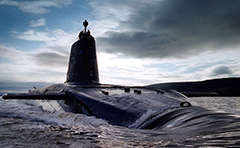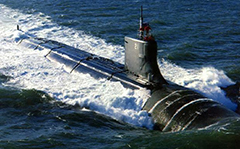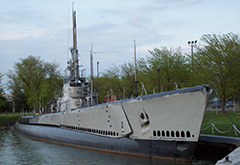1. The Largest Submarine in The U.S. Navy:
The Ohio class is a class of nuclear-powered submarines currently used by the United States Navy. The navy has 18 Ohio-class submarines: 14 ballistic missile submarines (SSBN) and four that were later converted to guided missile submarines (SSGN). The Ohio class was named after the lead submarine of this class, USS Ohio. The 14 Trident II SSBNs together carry approximately fifty percent of the total US active inventory of strategic thermonuclear warheads. Although the Trident missiles have no pre-set targets when the submarines go on patrol, the warships are capable of quickly being targeted using secure and constant radio communications links, including very low frequency (VLF) systems. More details
2. The Largest Submarine in World War II:
The Sen Toku I-400-class Imperial Japanese Navy submarines were the largest submarines of World War II and remained the largest ever built until the construction of nuclear ballistic missile submarines in the 1960s. They were submarine aircraft carriers able to carry three Aichi M6A Seiran aircraft underwater to their destinations. They were designed to surface, launch their planes, then quickly dive again before they were discovered. They also carried torpedoes for close-range combat. . They are considered the strategic predecessors to today’s ballistic submarines, especially to the Regulus missile program begun about a decade after World War II. More details
3. Typhoon Class Submarine:
Typhoon class submarine (Project 941 or Akula), is a type of nuclear-powered ballistic missile submarine deployed by the Soviet Navy in the 1980s. With a submerged displacement of 48,000 tonnes, the Typhoons are the largest class of submarine ever built, large enough to accommodate decent living facilities for the crew when submerged for months on end. The source of the NATO reporting name remains unclear, although it is often claimed to be related to the use of the word "typhoon" by Leonid Brezhnev in a 1974 speech while describing a new type of nuclear ballistic missile submarine, as a reaction to the US Navy Ohio-class submarines. More details
4. Vanguard Class Submarine:
The Vanguard class is a class of nuclear-powered ballistic missile submarines (SSBNs) in service with the Royal Navy. The class was introduced in 1994 as part of the Trident nuclear programme, and includes four boats: Vanguard, Victorious, Vigilant and Vengeance. They were built between 1986 and 1999 at Barrow-in-Furness by Vickers Shipbuilding and Engineering, which is now owned by BAE Systems. All four boats are based at HM Naval Base Clyde (HMS Neptune), 40 km (25 mi) west of Glasgow, Scotland. Since the decommissioning of the Royal Air Force WE.177 free-fall thermonuclear weapons in 1998, the four Vanguard submarines are the sole platforms for the United Kingdom's nuclear weapons. More details
5. Borei Class Submarine:
Borei Class (Project 955) is the new class of nuclear-powered ballistic missile submarine produced by Russia and operated by the Russian Navy, while the Severodvinsk-class submarine is the new Russian attack submarine. The class is intended to replace the Delta III, Delta IV and Typhoon classes now in Russian Navy service. The class is named after Boreas, the North wind. Despite being a replacement for many types of submarines, the Borei-class submarines are much smaller than those of the Typhoon class in both volume and crew (107 people as opposed to 160 for the Typhoons). The goal of this downsizing is to reduce the cost to build and maintain the submarines. More details
6. Seawolf Class Submarine:
The Seawolf class is a class of nuclear-powered fast attack submarines (SSN) in service with the United States Navy. The class was the intended successor to the Los Angeles class. Design work began in 1983. At one time, an intended fleet of 29 submarines was to be built over a ten-year period, later reduced to twelve submarines. The end of the Cold War and budget constraints led to the cancellation in 1995 of any further additions to the fleet, leaving the Seawolf class limited to just three boats. This, in turn, led to the design of the smaller Virginia class. More details
7. Akula Class Submarine:
Akula Class submarine (Project 971) is a nuclear-powered attack submarine (SSN) first deployed by the Soviet Navy in 1986. The class is also known under the name Bars (meaning "snow leopard"). There are four sub-classes or flights of Shchuka, consisting of the original seven Akula Is, commissioned between 1984 and 1990; six Improved Akulas, commissioned between 1991 and 2009; one Akula II, commissioned in 1995; and one Akula III, commissioned in 2001. The Russians call all of the submarines Shchuka-B, regardless of modifications. More details
8. Virginia Class Submarine:
The Virginia class, also known as the SSN-774 class, is a class of nuclear-powered fast attack submarines (SSN) in service with the United States Navy. The submarines are designed for a broad spectrum of open-ocean and littoral (shallow coastal water) missions. They were conceived as a less expensive alternative to the Seawolf-class attack submarines, designed during the Cold War era. They are replacing older Los Angeles-class submarines, many of which have already been decommissioned. Virginia-class submarines will be acquired through 2043, and are expected to remain in service past 2060. More details
9. Type VII U-Boat:
Type VII U-boats were the most common type of German World War II U-boat. The Type VII was based on earlier German submarine designs going back to the World War I Type UB III and especially the cancelled Type UG, designed through the Dutch dummy company Ingenieurskantoor voor Scheepsbouw den Haag (I.v.S) which was set up by Germany after World War I in order to maintain and develop German submarine technology and to circumvent the limitations set by the Treaty of Versailles, and was built by shipyards around the world. More details 10. USS Nautilus Submarine:
USS Nautilus (SSN-571) was the world's first operational nuclear-powered submarine and the first submarine to complete a submerged transit of the North Pole on 3 August 1958. Sharing names with Captain Nemo's fictional submarine in Jules Verne's classic 1870 science fiction novel Twenty Thousand Leagues Under the Sea, and named after another USS Nautilus (SS-168) that served with distinction in World War II, the new atomic powered Nautilus was authorized in 1951, with laying down for construction in 1952 and launched in January 1954. Final construction was completed in 1955. More details
11. Russian Nuclear Submarines:
A nuclear submarine is a submarine powered by a nuclear reactor. The performance advantages of nuclear submarines over "conventional" (typically diesel-electric) submarines are considerable: nuclear propulsion, being completely independent of air, frees the submarine from the need to surface frequently, as is necessary for conventional submarines; the large amount of power generated by a nuclear reactor allows nuclear submarines to operate at high speed for long periods of time; and the long interval between refuellings grants a range limited only by consumables such as food. More details
12. Nuclear Submarines:
A nuclear submarine is a submarine powered by a nuclear reactor. The performance advantages of nuclear submarines over "conventional" (typically diesel-electric) submarines are considerable: nuclear propulsion, being completely independent of air, frees the submarine from the need to surface frequently, as is necessary for conventional submarines; the large amount of power generated by a nuclear reactor allows nuclear submarines to operate at high speed for long periods of time; and the long interval between refuellings grants a range limited only by consumables such as food. More details
13. USS Texas Submarine:
USS Texas (SSN-775) is a Virginia-class submarine, and the fourth warship of the United States Navy to be named after the U.S. state of Texas. The contract to build her was awarded to the Northrop Grumman Newport News shipyard (then called Newport News Shipbuilding & Drydock Co.) in Newport News, Virginia on 30 September 1998 and her keel was laid down on 12 July 2002. She was christened on 31 July 2004 by Laura Bush, First Lady of the United States. She was launched into the James River on 9 April 2005. Under the command of Captain John Litherland, Texas arrived at Galveston Bay on 4 September 2006 and was escorted into the harbor by Elissa. More details
14. K-21 Submarine:
Soviet submarine K-21 was a K-class submarine of the Soviet Navy during World War II. The boat was laid on December 10, 1937 in Leningrad and launched on August 16, 1939. On February 3, 1941, it was commissioned as part of the Baltic Fleet under the command of Nikolai Lunin. On September 17, 1941, it was reenlisted in the Northern Fleet. On its first war patrol, K-21 laid 11 mines in the Strait of Best-Sung. On the morning of November 27, 1941, One of the mines struck and sank the Norwegian transport Bessheim. Between 9 November 1941 and 31 March 1942, K-21 unsuccessfully engaged three merchant ships and one German auxiliary patrol vessel. More details
15. U-995 Submarine:
German submarine U-995 is a Type VIIC/41 U-boat of Nazi Germany's Kriegsmarine. She was laid down on 25 November 1942 by Blohm & Voss in Hamburg, Germany, and commissioned on 16 September 1943 with Oberleutnant zur See Walter Köhntopp in command. German Type VIIC/41 submarines were preceded by the heavier Type VIIC submarines. U-995 had a displacement of 759 tonnes (747 long tons) when at the surface and 860 tonnes (850 long tons) while submerged. She had a total length of 67.10 m (220 ft 2 in), a pressure hull length of 50.50 m (165 ft 8 in), a beam of 6.20 m (20 ft 4 in), a height of 9.60 m (31 ft 6 in), and a draught of 4.74 m (15 ft 7 in). More details
16. USS Cod Submarine:
USS Cod is a Gato-class submarine, the only vessel of the United States Navy to be named for the cod, the world's most important food fish of the North Atlantic and North Pacific. Her keel was laid down by the Electric Boat Company of Groton, Connecticut on 21 July 1942. The submarine's five diesel engines were built by General Motors Cleveland Diesel Plant located on the west side of Cleveland. She was launched on 21 March 1943 (sponsored by Mrs. G.M. Mahoney), and commissioned on 21 June 1943 with Commander James C. Dempsey in command. More details
17. Manned Torpedo Submarine (Maiale):
Human torpedoes (manned torpedoes) are a type of diver propulsion vehicle on which the diver rides, generally in a seated position behind a fairing. They were used as secret naval weapons in World War II. The basic concept is still in use. The name was commonly used to refer to the weapons that Italy, and later (with a larger version) Britain, deployed in the Mediterranean and used to attack ships in enemy harbours. The human torpedo concept has occasionally been used by recreational divers. The concept of a tiny manned submarine carrying a bomb was developed and patented by a British naval officer in 1909, but was never used during the First World War. More details
18. Yasen Class Submarine:
The Yasen class, Russian designations Project 885 Yasen and Project 885M Yasen-M, also referred to as Graney class, are series of newest nuclear-powered cruise missile submarines designed by Malakhit and being constructed by Sevmash for the Russian Navy. Based on the Akula class and Alfa class designs, the Yasen class is projected to replace Russian Navy's current Soviet-era nuclear attack submarines. The vessel's design is claimed to be state-of-the-art. The Yasen-class nuclear submarines are presumed to be armed with land-attack cruise missiles, anti-ship missiles, anti-submarine missiles including the P-800 Oniks SLCM, Kalibr family SLCM or 3M51 SLCM. More details
19. U-32 Submarine:
U-32 (S182) is a Type 212A submarine of the German Navy, the second of her class to enter service. U-32 was built by the German Submarine Consortium at the shipyards of Thyssen Nordseewerke of Emden and Howaldtswerke-Deutsche Werft at Kiel. She was launched on 4 December 2003, and was commissioned in a joint ceremony with her sister ship U-31 by the German Minister of Defence, Peter Struck, in Eckernförde on 19 October 2005. U-32 is propelled by one diesel engine and an electric motor driven by two fuel cells and features a cavitation-free screw, making her virtually undetectable. U-32 was the first non-nuclear submarine to stay submerged for two weeks. More details
20. Delta III Class Submarine:
The Project 667BDR Kaľmar (Squid) Delta III-class submarine is a large ballistic missile submarine operated by the Russian Navy. Like other previous Delta-class submarines, the Delta III class is a double hulled design, with a thin low magnetic steel outer hull wrapped around a thicker inner pressure hull. The technical description and requirements for a new ballistic missile submarine were published in 1972. Development of Project 667BDR was begun at the Rubin Central Design Bureau for Marine Engineering under the direction of main designer Sergeiy Nikiticz Kovalev (Сергей Никитич Ковалёв). The submarine was to be a successor to the project 667BD. More details




















